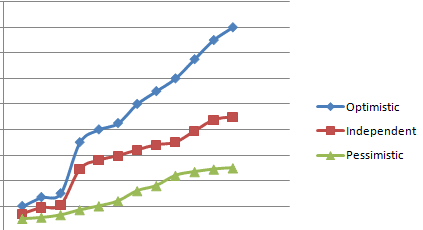Five methods to prove the efficiency and effectiveness of SEO
Calculating and proving the value of SEO isn't easy. Not only is there the misunderstanding of how SEO works when discussing SEO with senior stakeholders, but there’s also the added complexity of measurement in a world of ‘Not Provided keywords’.
While rankings can show us how we’re performing for a particular set of keywords, search results are now personalised and this does not demonstrate ROI. Factors including personalisation, localisation and limitations on the number of keywords one can track mean that rankings should be used more as a high-level KPI rather than a solid success metric.
At an executive level, ranking data will not effectively communicate the true value of organic search so we need to find methodologies that will enable us to speak the ‘language of the board room’ and generate buy-in for further activity.
Structure measurement around a framework
In this post I’m going to outline five different methods one can take to evaluate and demonstrate the effectiveness and efficiency of your SEO efforts. However, before looking at these methodologies it’s worth starting with an overview of two measurement frameworks we can use to frame our thinking and analysis:
Framework 1: VQVC - volume, quality, value, cost
With so much analytics data available to us through tools like Google Analytics, the VQVC framework as defined by Dave Chaffey can be used to help us ask the right questions and select the most appropriate KPIs to review commercial performance.
Therefore, when evaluating the organic search/ SEO data at our disposal, we need to consider the following:
- 1. Volume - what is the quantity/ volume of organic search traffic to the site?
- 2. Quality - does the content on site match the intent of the searcher, thus generating quality traffic?
- 3. Value - how does the quantity and quality of organic search traffic translate into a commercial transaction?
- 4. Cost - what is the cost of our SEO efforts?
You will need to isolate organic, SEO traffic using Advanced segments to compare it to other visitor referrers to your sites.
Framework 2 - RACE- reach, act, convert, engage
The Smart Insights RACE planning framework can be used to simplify and articulate measurement and reporting by considering the key online marketing activities that need to be managed as part of a digital marketing strategy:
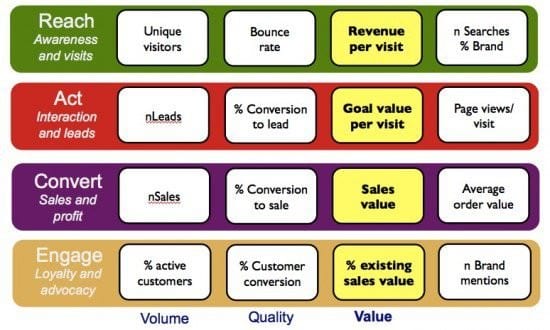
As can be seen in the graphic above, RACE looks at metrics at each stage of the purchase funnel and takes into consideration the VQVC elements covered in the previous section.
RACE is a particularly important framework because whilst SEO will often play a stronger role in the Reach phase, it can also contribute in any of the other four stages:
- 1. Reach - building brand awareness by maximising reach.
- 2. Act - encouraging interactions to generate leads.
- 3. Convert - conversion to sale.
- 4. Engage - developing long-term relationships to build customer loyalty and repeat purchases.
* There is also an initial phase of Plan, which can be used before the Reach phase and important for strategy, objective setting and business case analysis (as you’ll see below).
Methodologies for measuring SEO value
As with any digital marketing tactic, the objective is to add value for the business. And in order to determine a tactic’s effectiveness, we need to be able to measure the value it drives as outlined in the frameworks discussed above.
Below is a set of five techniques for measuring SEO value:
1. Conduct an SEO gap analysis
RACE phase - Plan
VQVC phase - Volume
- Before beginning any SEO activity, the first stage involves thinking about what type of content to optimise based on the products and services you offer. This includes keyword research and an SEO gap analysis to build an understanding of how many visits and potential sales you are attracting to your site as a share of the total demand based on consumer intent, i.e. the number of searches by those looking for new products and services.
Whilst an SEO gap analysis is a fairly standard SEO practice, ‘Not Provided’ has made this process more difficult because the search terms entered by searchers are unknown. However, Dave Chaffey has put together a useful tutorial for estimating share of search using Google’s Webmaster Tools and search queries data .
The keyword-level data offered by Google via Webmaster Tools is far from perfect and there are limitations to be aware of, but that said, this method does at least give you an indication of the type of visits different keywords are delivering which can then be imported into a gap analysis template.
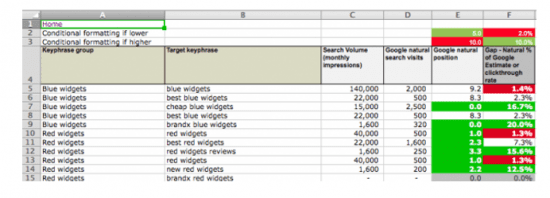
Share of voice adds context. It allows you to see what product areas are strong and what areas are weak, enabling you to prioritise strategy decisions.
2. Forecast the potential benefits of SEO using search volume and CTR
RACE phase - Plan, Reach
VQVC phase - Volume and Value
I covered this particular methodology in a previous post and it is still relevant for those looking to provide a high-level business case for SEO investment.
Following a gap analysis and the identification of focus keywords, ranking data, search volume, CTR and conversion rate can be used to create a forecast for potential organic search traffic and revenue.
The steps in this process involve:
- 1. Estimate search volume for top terms using the Google Keyword Planner.
- 2. Estimate Google Click-through rate percentage using a Google SERPs CTR distribution curve.
- 3. Plot within a graph where you want to improve rankings, i.e. from position X to Y, and how this improves traffic.
- 4. This will give you a high-level indication of organic search traffic from this particular set of keywords, from which you can apply your own visit to sale conversion rate and average order value to estimate revenue.

3. Estimate value of SEO using the payback model
RACE phase - Plan
VQVC phase - Value
Using the learnings you may have from previous SEO work and the site conversion rate data you have at your disposal, it may be possible to work out the payback period for a particular project:

In the example above, the project will be paid back after approximately 2.25 months.
This approach is useful for SEO because optimisation efforts accrue benefits over time and is a good way of aligning activity with metrics senior executives are more likely to be interested in.
4. Focus on landing pages rather than keywords
RACE phase - Reach
VQVC phase - Volume
Once you’ve built your SEO business case and activity has started, analysis and reporting can begin.
As mentioned at the outset of this post, keyword-level data is no longer available, at least not to an accurate level, and we must therefore elevate our methodologies from keyword to page-level analysis.
Google Webmaster Tools provides a set of keywords associated with top landing pages on your website:

Despite the limitations and caveats Google Webmaster Tools data, this will at least provide an indication of top keywords by landing page, which can be used alongside Google Analytics to assess how your search engine optimisation efforts for these keywords have resulted in an increase in overall organic search visits for each top landing page. This can then be used to correlate improvements in SERP visibility with traffic to your website:
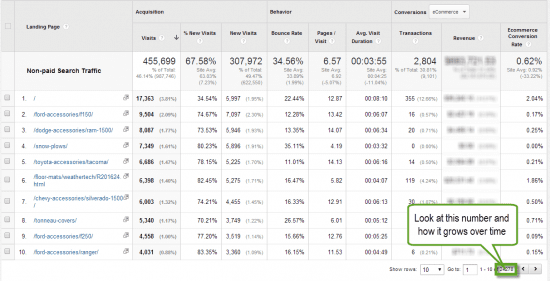
5. Measure SEO using paid search equivalence
RACE phase - Reach, Act, Convert
VQVC phase - Quality, Value
To get a really clear measure of performance at a business level, SEO success metrics must align with the wider business metrics a marketing director or CMO will be looking for, e.g. revenue, net profit, sales, average order value.
One way to achieve this is by measuring SEO in the same way as PPC. With many companies integrating SEO and PPC, this will enable them to more closely align their search marketing efforts to achieve cost efficiencies. However, even if you’re not running PPC campaigns, measuring SEO using the PPC model will allow you to articulate the value SEO is generating using language your executives will understand.
There are six key steps to check the value of your SEO
- Step 1. Value organic search traffic using paid search cost-per-click values to calculate the equivalent media spend value of the traffic if it were being paid for. Due to the complications with ‘Not provided’, you use the methodology from method 2, above, to model the value of top landing pages. Alternatively, tools such as SEMrush can be used to provide a value estimate by landing page by assessing the traffic being driven by top keywords:
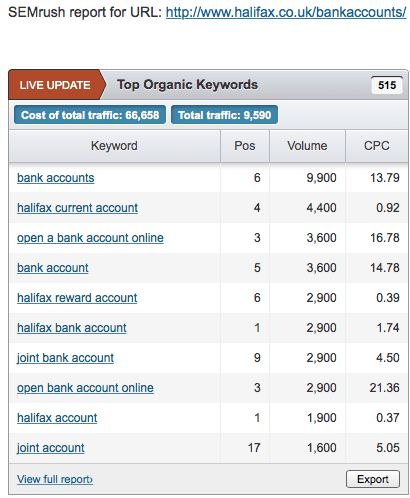
- Step 2. Using a the methodology from method 1, above, calculate the revenue value of organic search traffic by applying a conversion rate and average order value. This will give you a baseline from which to measure your ongoing SEO activity.
- Step 3. Perform keyword research and a competitor gap analysis [] to understand where you are vs competitors.
- Step 4. Take a view of the market to understand your share vs competitors. By looking at ranking data, predicted traffic levels and the value of clicks using paid search media equivalence, estimate the value your competitors are generating from SEO and get a picture of your share vs theirs, thus highlighting the potential revenue from increasing your SEO activity.
- Step 5. Similarly to paid search, categorise SEO keywords into ad buckets so you have clear targets on areas to improve and the potential value of traffic that’s available.
- Step 6. By understanding what’s possible, you’ll be able to draw up an action plan for activity and provide an SEO forecast covering what’s optimistic, realistic and pessimistic, e.g.:
